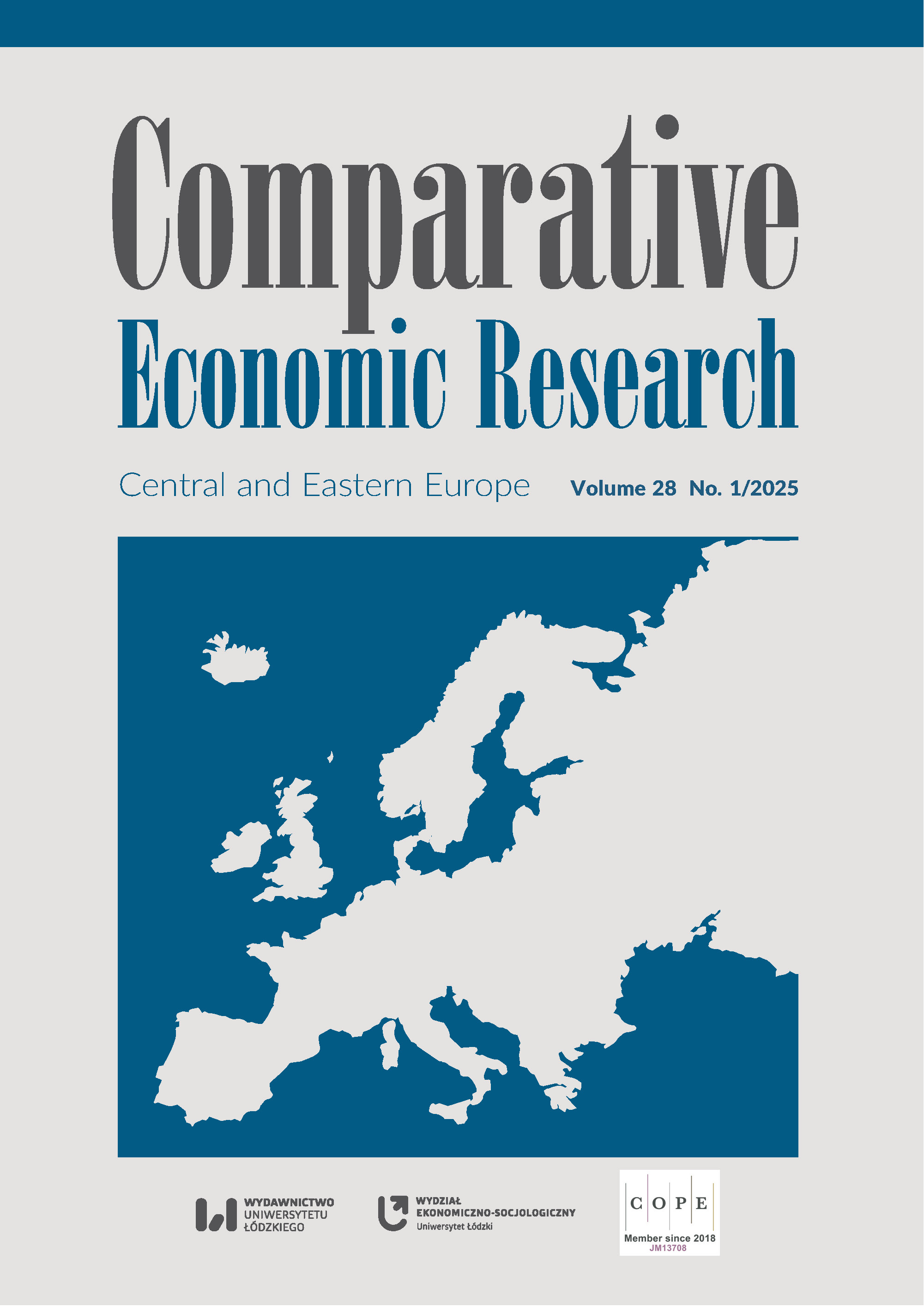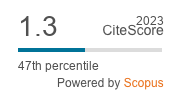Food Processing Industries in Visegrad Countries in Global Value Chains (1995–2018)
DOI:
https://doi.org/10.18778/1508-2008.28.06Keywords:
European Union, fragmentation of production, participation, value added, vertical specializationAbstract
The aim of the article is to evaluate the position in global value chains (GVCs) of food processing industries in the Visegrad countries (V4; Poland, Czechia, Hungary and Slovakia) between 1995 and 2018. To identify the intensity and forms of integration in GVC of these industries in each country and to compare it to the other V4 countries, we employed complex methods to measure the importance of foreign demand, (backward and forward) participation and position in GVCs, the territorial context of integration, and shifting patterns of the integration into GVCs using data from the TiVA database.
Our findings revealed variations in the integration of food processing industries in GVCs in the V4 countries. Common characteristics and trends were observed (e.g., increasing participation) until the Great Recession before stalling, increasing integration into European value chains, and absorption of foreign value added mostly from services industries. These trends are consistent with findings from previous studies.
A significant contribution of this study is that it reveals how food exports from the Czech Republic, Hungary and Slovakia are mostly linked to increased GVC participation. Notably, food processing industries in Hungary and Slovakia have continued to increase their participation in GVCs even after the Great Recession. Given the evidence of beneficial economic outcomes from increased participation in GVCs, this implies that the food processing industries in Hungary and Slovakia will become more competitive. Food industries in Poland and Hungary are positioning themselves relatively more downstream in the GVCs, while shifts in the Czech Republic and Slovakia are increasingly upstream. Given evidence of beneficial economic outcomes from increased participation in GVCs being more downstream in the GVCs, the V4 countries will need to evaluate how their trajectories may impact the future wellbeing of businesses and employees working in these industries.
Downloads
References
Antalóczy, K., Gáspár, T., Sass, M. (2019), The Specialties of the Pharmaceutical Value Chains in Hungary, “Acta Oeconomica”, 69, pp. 41–72, https://doi.org/10.1556/032.2019.69.s2.3
Google Scholar
DOI: https://doi.org/10.1556/032.2019.69.s2.3
Borin, A., Mancini, M. (2019), Measuring What Matters in Global Value Chains and Value-Added Trade, “Policy Research Working Paper”, 8804, The World Bank, https://doi.org/10.1596/1813-9450-8804
Google Scholar
DOI: https://doi.org/10.1596/1813-9450-8804
Cieślik, E. (2017), Central and Eastern European states in global production linkages: country-level and sector-level analysis, “Przeglad Europejski”, 44 (2), pp. 38–60, https://doi.org/10.31338/1641-2478pe.2.17.3
Google Scholar
DOI: https://doi.org/10.31338/1641-2478pe.2.17.3
Cieślik, E. (2019), Shifting from the EU’s production networks? Electronics industry exports of Central and Eastern Europe, “Applied Economics Letters”, 27 (1), pp. 52–57, https://doi.org/10.1080/13504851.2019.1606406
Google Scholar
DOI: https://doi.org/10.1080/13504851.2019.1606406
Cieślik, E., Biegańska, J., Środa-Murawska, S. (2016), The intensification of foreign trade in post-socialist countries and their role in global value chains, “Acta Oeconomica”, 66 (3), pp. 465–487, https://doi.org/10.1556/032.2016.66.3.5
Google Scholar
DOI: https://doi.org/10.1556/032.2016.66.3.5
Cieślik, E., Biegańska, J., Środa-Murawska, S. (2019), Central and Eastern European States from an International Perspective: Economic Potential and Paths of Participation in Global Value Chains, “Emerging Markets Finance and Trade”, 57 (13), pp. 3587–3603, https://doi.org/10.1080/1540496X.2019.1602519
Google Scholar
DOI: https://doi.org/10.1080/1540496X.2019.1602519
Constantinescu, C., Mattoo, A., Ruta, M. (2019), Does vertical specialization increase productivity?, “The World Economy”, 42 (8), pp. 2385–2402, https://doi.org/10.1111/twec.12801
Google Scholar
DOI: https://doi.org/10.1111/twec.12801
De Backer, K., Miroudot, S. (2013), Mapping Global Value Chains, OECD Publishing, Paris, https://doi.org/10.2139/ssrn.2436411
Google Scholar
DOI: https://doi.org/10.2139/ssrn.2436411
Dellink, R., Dervisholli, E., Nanci, S. (2020), A quantitative analysis of trends in agricultural and food global value chains (GVCs), Background paper for The State of Agricultural Commodity Markets, FAO, Rome.
Google Scholar
Dicken, P. (2011), Global Shift: Maping the Changing Contours of the World Economy, The Guilford Press, New York.
Google Scholar
Elia, S., Fratocchi, L., Barbieri, P., Boffelli, A., Kalchschmidt, M. (2021), Post-pandemic reconfiguration from global to domestic and regional value chains: the role of industrial policies, “Transnational Corporations Journal”, 28 (2), pp. 67–96.
Google Scholar
DOI: https://doi.org/10.18356/2076099x-28-2-3
Gereffi, G. (2014), Global value chains in a post-Washington Consensus world, “Review of Interna-tional Political Economy”, 21 (1), pp. 9–37, https://doi.org/10.1080/09692290.2012.756414
Google Scholar
DOI: https://doi.org/10.1080/09692290.2012.756414
Gereffi, G., Fernandez-Stark, K. (2018), Global Value Chain Analysis: A Primer, [in:] G. Gereffi (ed.), Global Value Chains and Development: Redefining the Contours of 21st Century Capitalism, Cambridge University Press, Cambridge, pp. 305–342, https://doi.org/10.1017/9781108559423
Google Scholar
DOI: https://doi.org/10.1017/9781108559423.012
Hummels, D., Ishii, J., Yi., K.M. (2001), The nature and growth of vertical specialization in world trade, “Journal of International Economics”, 54 (1), pp. 75–96, https://doi.org/10.1016/S0022-1996(00)00093-3
Google Scholar
DOI: https://doi.org/10.1016/S0022-1996(00)00093-3
Ignatenko, A., Raei, F., Mircheva, B. (2019), Global Value Chains: What are Benefits and Why Do Countries Participate?, “IMF Working Papers”, 2019/018, International Monetary Fund.
Google Scholar
Johnson, R.C., Noguera, G. (2012), Accounting for intermediates: Production sharing and trade in value added, “Journal of International Economics”, 86 (2), pp. 224–236, https://doi.org/10.1016/j.jinteco.2011.10.003
Google Scholar
DOI: https://doi.org/10.1016/j.jinteco.2011.10.003
Jurčić, L.J., Franc, S., Barišić, A. (2020), Impact of Institutional Quality on Foreign Direct Investment Inflow: Evidence from Croatia, “Business Systems Research”, 11 (1), pp. 44–58, https://doi.org/10.2478/bsrj-2020-0004
Google Scholar
DOI: https://doi.org/10.2478/bsrj-2020-0004
Kaminski, B., Ng, F. (2005), Production disintegration of Central Europe into global markets, “International Review of Economics and Finance”, 14 (3), pp. 377–390, https://doi.org/10.1016/j.iref.2004.12.008
Google Scholar
DOI: https://doi.org/10.1016/j.iref.2004.12.008
Kersan-Škabić, I. (2017), Assessment of EU member states’ positions in Global Value Chains, “Eastern Journal of European Studies”, 8 (2), pp. 5–24.
Google Scholar
Kersan-Skabić, I., Barisic, A. (2023), Foreign direct investments and participation in global value chains: New evidence from advanced manufacturing industries in Central and Eastern Europe, “E&M Economics and Management”, 26 (4), pp. 4–16, https://doi.org/10.15240/tul/001/2023-4-001
Google Scholar
DOI: https://doi.org/10.15240/tul/001/2023-4-001
Kersan-Škabić, I., Belullo, A. (2021), The Characteristics of Regional Value Chains in the Sector of Chemicals and Pharmaceutical Products in the EU, “Economies”, 9 (4), pp. 1–24, https://doi.org/10.3390/economies9040167
Google Scholar
DOI: https://doi.org/10.3390/economies9040167
Kohut, D. (2023), Mapping Agricultural GVC in the European Union, “World Economy and Policy”, 2 (1), pp. 1–17, https://doi.org/10.18267/j.wep.182
Google Scholar
DOI: https://doi.org/10.18267/j.wep.182
Koopman, R., Powers, W., Wang, Z., Wei, S.J. (2010), Give Credit Where Credit Is Due: Tracing Value Added in Global Production Chains, “NBER Working Paper Series”, 16426, National Bureau of Economic Research, Cambridge, https://doi.org/10.3386/w16426
Google Scholar
DOI: https://doi.org/10.3386/w16426
Kuzmenko, E., Cechura, L. (2023) Decomposition analysis of global value chains: Uncovering vulnerable spots in a selected economy (the example of Czechia), “Helion”, 9 (5), pp. 1–16, https://doi.org/10.1016/j.heliyon.2023.e15763
Google Scholar
DOI: https://doi.org/10.1016/j.heliyon.2023.e15763
Lim, S. (2021), Global Agricultural Value Chains and Structural Transformation, “NBER Working Paper Series”, 29194, National Bureau of Economic Research, Cambridge, https://doi.org/10.3386/w29194
Google Scholar
DOI: https://doi.org/10.3386/w29194
Lim, S., Kim, S.W. (2022), Global agricultural value chains and employment growth, “Journal of the Agricultural and Applied Economics Association”, 1 (4), pp. 402–418, https://doi.org/10.1002/jaa2.34
Google Scholar
DOI: https://doi.org/10.1002/jaa2.34
Martins Guilhoto, J., Webb, C., Yamano, N. (2022), Guide to OECD TiVA Indicators, OECD Publishing, Paris.
Google Scholar
Nacewska-Twardowska, A. (2022), Poland and global value chains at the beginning of the 21st century – An opportunity or a threat?, “International Journal of Management and Economics”, 58 (1), pp. 1–11, https://doi.org/10.2478/ijme-2022-0004
Google Scholar
DOI: https://doi.org/10.2478/ijme-2022-0004
Nenci, S., Fusacchia, I., Giunta, A., Montalbano, P., Pietrobelli, C. (2022), Mapping global value chain participation and positioning in agriculture and food: stylized facts, empirical evidence and critical issues, “Bio-based and Applied Economics”, 11 (2), pp. 93–121, https://doi.org/10.36253/bae-12558
Google Scholar
DOI: https://doi.org/10.36253/bae-12558
OECD (2016), Global Value Chains and Trade in Value-Added: An Initial Assessment of the Impact on Jobs and Productivity, OECD Publishing, Paris.
Google Scholar
OECD (2020), Global value chains in agriculture and food: A synthesis of OECD analysis, OECD Publishing, Paris.
Google Scholar
Reardon, T., Timmer, C. (2007), Transformation of Markets for Agricultural Output in Developing Countries Since 1950: How Has Thinking Changed?, [in:] R.E. Evenson, P. Pingali (eds.), Handbook of agricultural economics, 3, Elsevier, Amsterdam, pp. 2807–2855, https://doi.org/10.1016/S1574-0072(06)03055-6
Google Scholar
DOI: https://doi.org/10.1016/S1574-0072(06)03055-6
Shaffer, R., Deller, S., Marcouiller, D. (2004), Community Economics: Linking Theory and Practice, Blackwell Publishing, Ames.
Google Scholar
TiVA (2023), Trade in value-added, https://1url.cz/euWcm (accessed: 3.05.2023).
Google Scholar
Trienekens, J. (2011), Agricultural Value Chains in Developing Countries: A Framework for Analysis, “International Food and Agribusiness Management Review”, 14 (2), pp. 51–82.
Google Scholar
Vakhal, P. (2023), The evolution of downstream global value chains in Eastern Europe, “Society and Economy”, 45 (3), pp. 270–292, https://doi.org/10.1556/204.2023.00006
Google Scholar
DOI: https://doi.org/10.1556/204.2023.00006
Venger, V., Romanovska, N., Chyzhevska, M. (2022), Integration of Ukraine to the Global Value Chains, “Comparative Economic Research. Central and Eastern Europe”, 25 (2), pp. 137–161, https://doi.org/10.18778/1508-2008.25.17
Google Scholar
DOI: https://doi.org/10.18778/1508-2008.25.17
Ženka, J., Pavlínek, P. (2013), Český automobilový průmysl v globálních produkčních sítích: regionální souvislosti rozvoje v období 1998–2008, “Geografie”, 118 (2), pp. 116–137, https://doi.org/10.37040/geografie2013118020116
Google Scholar
DOI: https://doi.org/10.37040/geografie2013118020116
Downloads
Published
How to Cite
Issue
Section
License

This work is licensed under a Creative Commons Attribution-NonCommercial-NoDerivatives 4.0 International License.











